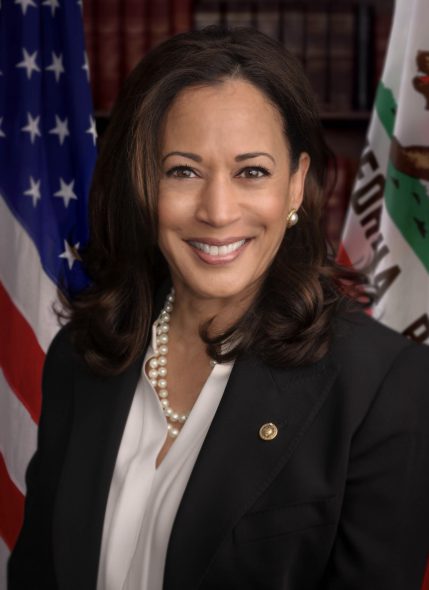Kamala Is Dead Wrong on Busing
And the Milwaukee busing plan was a dramatic example of this.
Kamala Harris will need a strong turnout by Milwaukee’s (and Wisconsin’s) African American voters to prevail in next year’s Wisconsin’s primary election. In advance of a visit to the state, she might read up on the Milwaukee’s disastrous experience with busing to desegregate the schools, a failed “progressive” policy carried out to the distinct disadvantage of black families.
Harris has put some space between her and other challengers with this verbal swipe, in a recent debate, at frontrunner Joe Biden: “…[D]o you agree today that you were wrong to oppose busing” for school desegregation?” When it became clear the attack had legs with liberal Democrats, her campaign website began featuring a T-shirt with a picture of her as a young girl. The image evokes her line during the debate — “that little girl was me” — about her personal experience with busing.
It’s been two decades since citizens reached a consensus that Milwaukee’s forced busing program was a failure. Consider this from a 1999 Journal Sentinel article:
Matching a nationwide…trend, Milwaukee-area residents strongly oppose the practice of busing children from one neighborhood to an other for the purpose of integration, according to results of an extensive Journal Sentinel poll.
Of the 800 adults polled…in the metropolitan Milwaukee area, 73% said they did not support busing for integration – a resounding condemnation of two decades’ worth of social policy in the city.
Opposition to busing was slightly less strong among respondents who live in the city (66%) but still represented a solid majority. By race, 78% of white respondents opposed busing; 56% of blacks opposed the policy.
After being confronted in the debate by Harris, Biden has conducted a pitiful campaign of bobbing and weaving. Instead of answering “NO” to her question, he has backpedaled into a spate of unpresidential waffling. He should have disputed her history and gone on to cite experiences in cities such as Milwaukee and Boston to justify his skepticism about forced busing.
Following the Harris-Biden exchange, Boston Globe columnist Jeff Jacoby wrote a column under the headline “Biden was right. Busing was wrong.” He said:
The forced busing of schoolchildren for purposes of racial desegregation was a wretched, wrongheaded policy that caused far more harm than good. As a young, liberal Democratic senator 45 years ago, Biden firmly opposed busing, and he was right to do so.
In the days following the [Harris-Biden exchange], the liberal media chorus declared that of course opposition to forced busing was wrong, of course Biden had been on “the wrong side of history,” and of course he should acknowledge the error of his ways. A visitor from Mars could be forgiven for assuming that racial busing had been wise and beneficial, and that no reasonable mind could deny it.
On June 21, 1974, US District Judge W. Arthur Garrity issued an order to desegregate Boston’s public schools through massive crosstown busing of the city’s schoolchildren. It was the first of what would add up to some 400 orders signed by Garrity over the next 11 years, and it had the staunch support of Boston’s most important institutional voice of racially enlightened liberalism: The Boston Globe.
Twenty years later, the Globe’s support had vanished.
“Busing has been a failure in Boston,” the editorial board concluded bluntly in June 1994. “It achieved neither integration nor better schooling.” Repudiating the “delusions and pretensions that drove the busing controversy,” the Globe called for an end to the “obsessive, dead-end tinkering with racial proportions”…
…In 1982, a Globe poll found that only 14 percent of black Boston parents still favored busing. The overwhelming majority preferred a free-choice plan, allowing parents to send their children to any public school in the city. In practice, that would have meant schools their kids could walk to.
White opposition to forced busing scared Milwaukee’s leaders, who created a very different plan in response to a federal court order to desegregate the schools. The plan launched in 1976 allowed white students to chose integration at magnet schools with specialized programs, while putting the burden of forced busing on black students, as research by Lois Quinn and the Metropolitan Integration Research Center documented a few years later. In the early 1980s Howard Fuller began building opposition to the disruptive and disproportionate burden placed on black families and children with the supposedly “peaceful” desegregation plan implemented in Milwaukee. His later doctoral thesis at Marquette University helped blow a hole in sanitized and misleading reporting by the Milwaukee Journal and Milwaukee Sentinel, which supported the busing program. Maps that I included in a study expanding on Quinn’ research showed students from individual neighborhood schools were being bused to as many as 100 separate schools across the city.
Subsequent research by James Kenneth Nelsen, a doctoral candidate in history at the University of Wisconsin-Milwaukee, offered a clear description of how the system worked:
There was no room in the [Black] school[s] — [they were] usually overcrowded to begin with…Black students had to move to accommodate whites. Some African American parents complained about waiting lists to get into what had been their neighborhood schools… Now that their schools had more desirable programs [for white students], they could no longer attend them.
It was not until the late 1990s that David Bennett, a deputy to former MPS Superintendent Lee McMurrin admitted that the forced busing plan he and McMurrin developed was built around “white benefit,” namely, the goal of reducing “white flight.” Bennett’s stunning confirmation produced exactly one story in the local press, at which point the editors and the rest of Milwaukee’s establishment “moved on.”
While the Boston and Milwaukee busing plans were designed very differently, it’s clear neither worked. So when Kamala Harris visits Milwaukee and Wisconsin, will the Journal Sentinel — or anyone in the media — step up and ask her to reconcile her rose-colored vision of busing with the reality of its experience in Wisconsin?
The Contrarian
-
Parents May ‘Break Up’ MPS
 Feb 8th, 2022 by George Mitchell
Feb 8th, 2022 by George Mitchell
-
School Choice Key Issue in Governor Race
 Sep 1st, 2021 by George Mitchell
Sep 1st, 2021 by George Mitchell
-
Jill Underly Flunks School Choice 101
 Feb 22nd, 2021 by George Mitchell
Feb 22nd, 2021 by George Mitchell


















;And the reason desegregation didn’t work is because white folks and overall public opinion opposed it. The scales of justice I was always led to believe weighed not public opinion but the rights and responsibilities as outlined by the law and the constitution. Having lived in Louisville during the desegregation of the schools, I can tell you it wasn’t pretty but it proved one core value of this country – “money follows white skin”! And then look at the test scores from desegregated schools! I think what you will find is that scores for African American students match or come close to matching their white counterparts and all maintain or rise together. Desegregation didn’t “fail” what failed is the commitment to a society which offered equality of opportunity for all including children!
The facts, the state empowered suburban areas special rules for incorporation to prevent annexation by Milwaukee with the “Oak Creek Law” after Brown v. Board of Education. The facts, Milwaukee Metro Area, is one of the most segregated in North America.
We have a racist legacy, and unified school districts that cross municipal boundaries would make integration more natural. Urban-Suburban boundaries in America were strongly motivated by racism because busing was effectively limited to the school district boundaries.
Even today, talk of building integration friendly housing in places like New Berlin gives rise to protestors, some which only thinly disguise their racism. We hardly take notice of outstate consolidations of school districts for economic reasons or bussing for financial goals in all white communities. The fact is, racism is a factor. Because politicians’ primary purpose is political power, manipulating people of all colors is a central strategy done without the intent of correcting systemic social injustice.
Nobody wants to discuss the lurking problems of systemic racism, which is why all solutions to date have been superficial and ineffective.
I am glad that Kamala Harris brought up the subject so maybe we can start honestly discussing the problem.
Racism is the root of everything.
Maybe it’s just a white Milwaukee problem. I was brought up in CA and it appears to me it has a lot more going for it in terms of segregation. The midwest is behind in a lot more than manufacturing…
There were many complex features of the Milwaukee desegregation plan implemented in the 1970s, but I don’t believe they support Joe Biden’s 1970s opposition to “forced busing” in metro Wilmington over Kamala Harris’ position (as I understand it) that mandatory busing is one critical tool for addressing racial segregation in schools. Our research on Milwaukee’s desegregation process suggests that it was not “forced busing” but “voluntary busing” that contributed to the scattering of African American students from some innercity schools to over 100 schools throughout the city while allowing white students to continue attending their under-capacity neighborhood schools or to “volunteer” for a specialty school program in an African American neighborhood. In 1976 the Milwaukee Board of School Directors (which had opposed school desegregation in the courts) adopted what they called a “freedom of choice” plan with educational incentives to induce parents to volunteer for schools outside of their neighborhoods. The school board “rules” underlying these “choices” had very different consequences for white students than for African Americans, as a number of African American schools were closed, given lowered enrollment caps, or converted into “specialty schools” with spaces reserved for white student volunteers, while nearly all schools in predominantly white neighborhoods remained untouched by student capacity issues. I believed then, and believe now, that these “choice” options were discriminatory. The paper we prepared for the Metropolitan Integration Research Center in 1980 describing this plan (“Relationships Between School Desegregation and Government Housing Programs: A Milwaukee Case Study”) is available online at https://dc.uwm.edu/eti_pubs/175/.
Notably, the “Committee of 100,” an advisory group created in 1976 by the school board and composed of parents elected from schools in the district, endorsed a “pairing and clustering” desegregation plan that would have created integrated school communities throughout the city and would have required ALL students (including whites) to bus for a portion of their school career. This proposal for mandatory (i.e., “forced”) busing was also endorsed by the Coalition for Peaceful Schools, an organization of religious, civic, nonprofit and parent groups supporting peaceful school desegregation. The school board and its lawyers categorically rejected this approach.
There is much to learn about metro Milwaukee’s historic efforts, and non-efforts, to address school and housing segregation. My research on Milwaukee does not support George Mitchell’s claim that Kamala Harris is “dead wrong on busing.” More importantly, the proposals introduced by Harris and other presidential candidates to finally attempt to redress the systemic discrimination against families of color in obtaining federal housing loans and FHA and VA insurance offer new promise for improvements in racial equity for metro Milwaukee and other communities.